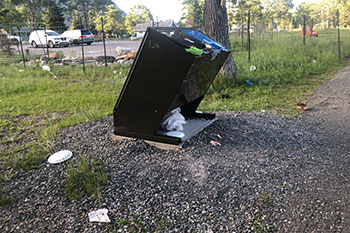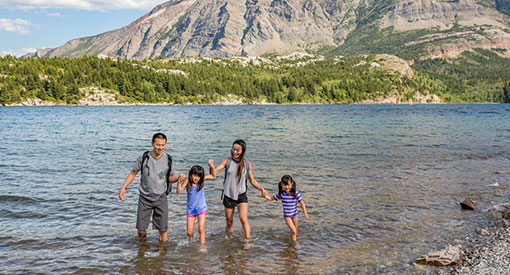Play your part in a litter-free Waterton Lakes National Park
Waterton Lakes National Park
The majority of our visitors clean up after themselves and take their garbage away.

Unfortunately, some leave their garbage behind on trails, at picnic areas and next to waste bins, which not only spoils the enjoyment for others, but is also a risk to our wildlife.
Leaving food and garbage out can attract wildlife. All visitors must dispose of waste properly in bear-proof garbage bins, thoroughly clean their picnic sites, and never leave food or attractants unattended.
Observing wildlife in their natural habitat is a privilege that comes with a responsibility to treat animals with the respect they deserve and need. It is important for visitors to remember that they share the surrounding habitat with wildlife and take the steps necessary to keep themselves and wildlife safe.
Keeping wildlife wild is a shared responsibility - we all have a role to play.
How you can help
- Leave No Trace. Garbage should be disposed of properly. Pack it in, pack it out. Inspect your campsite, food preparation areas, and rest areas for trash or spilled foods. Pack out all trash, leftover food and litter
- Keep food and garbage secure. Wildlife is attracted to food and non-food items that smell like food including garbage, dishes, pots, coolers and even toiletries
- Bring a garbage bag to hold trash until you can find a bin or take it home
- Pack out toilet paper and hygiene products
- Bring your own reusable dishes and water bottles
- Never feed wildlife
- Give wildlife space
- Respect all warnings and closures
Visitors should report bear sightings of concern and ALL unsecured food/garbage immediately to Parks Canada Dispatch at 1-888-927-3367. Together, we can contribute to the successful coexistence of people and wildlife.
Parks Canada makes every effort to manage waste and empties all bins as quickly as possible. It is not acceptable to leave food on the ground beside a bin if it is full. Find another bin or pack it home. Bring hand sanitizer to use after handling high-touch surfaces such as bin handles.
Human and wildlife safety is of the utmost importance to Parks Canada and we work to promote coexistence between people and wildlife, by educating park visitors, providing bear-proof food garbage bins and food storage facilities, researching and monitoring wildlife, and engaging in compliance and enforcement efforts.
But keeping the park clean and wildlife safe is a shared responsibility. We need your help.
Why is human food bad for wildlife?
Wildlife need to find their own natural food sources, not yours.
The act of hand feeding wild animals; leaving food, cooking utensils and scented items out when not in use; and littering or not properly disposing of garbage can lead to animals learning that humans can be a source of food.

Once an animal has accessed human food or garbage, there is a significant risk that it will continue to seek unnatural food from people or visitor areas.
When an animal learns to associate people with food, or become “food conditioned”, the animal will frequent areas that are unsafe, such as roadsides or parking lots, and may begin to adopt bold or aggressive behaviours towards people. This puts the safety of people and the animal at risk.
Parks Canada occasionally needs to euthanize animals that have become a public safety risk. In addition, animals are adapted to eating their own natural food sources, not human food and garbage. They often ingest plastic, chemicals and other material that may be harmful to their health. If they become dependent on artificial sources of food, then they may have difficulty when these sources of food later disappear.
Feeding wildlife in a national park or historic site is illegal and you can be charged under the Canada National Parks Act. This includes feeding them directly by offering them food, or indirectly by leaving food unattended, littering, or not properly disposing of garbage.
Related links
- Date modified :
